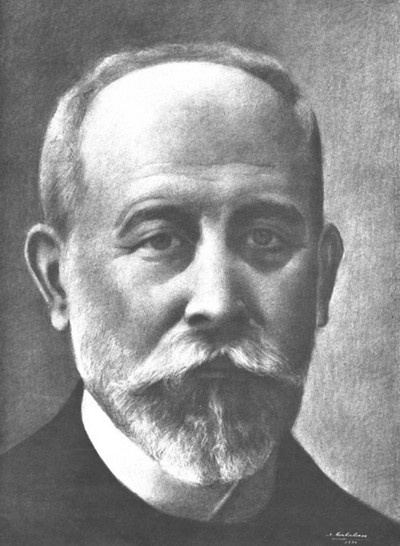Florentino Ameghino (Florentino Ameghino)

Born in Luján, son of Italian immigrants, Ameghino was a self-taught naturalist, and focused his study on the lands of the southern Pampas. He formed one of the largest collections of fossils of the world at the time, which served him as base for numerous geological and paleontological studies. Ameghino was a leading pioneer in the development of phylogenetics and of the paleontological approach of evolutionary biology. He also investigated the possible presence of prehistoric man in the Pampas and made several controversial claims about human origins in South America. Domingo Faustino Sarmiento, president of Argentina 1868–1874, described Ameghino as “a countryman from Mercedes that nobody knows of here, but that is admired by scholars worldwide.”
The Antiquity of Man in the Río de la Plata, later translated into French, was published in 1878. Phylogeny, published in 1884, was a theoretical work on developing an evolutionary concept in the Lamarckian vein, and led to the establishment of zoological taxonomy as a discipline with mathematical foundations. He later directed the Department of Zoology at the National University of Córdoba, which awarded him with an honorary doctorate, and was inducted into the National Academy of Sciences of Argentina. Ameghino worked with Francisco P. Moreno, founder and director of the La Plata Museum, as deputy director, secretary, and director of the Paleontology Department upon its establishment in 1888. Ameghino enriched his department with his own collection, which he sold to the provincial government for the purpose. But it was little time in which these two scientists worked together. A year later his magnum opus appeared in the Proceedings of the National Academy of Sciences, Mammalian Fossils in the Argentine Republic, comprising 1028 pages and an atlas. This latter contribution to the knowledge of the fossil mammals of Argentina won the bronze medal at the Exposition Universelle (1889) in Paris.
He later served as director of the Bernardino Rivadavia Natural Sciences Museum, in Buenos Aires, and in 1906 published Sedimentary Formations of the Cretaceous and Tertiary Eras in Patagonia, a work of synthesis is not limited to descriptions, but it raises hypotheses about the evolution of various mammals and analyzes the different layers of the crust and their possible ages. Ameghino returned between 1907 and 1911 to his earlier dedication: anthropology, the descriptions of the first inhabitants, industries and cultures.
His published works include 24 volumes of between 700 and 800 pages each, containing classifications, studies, comparisons and descriptions of more than 9000 extinct animals, many discovered by him. This was an important contribution to the known catalog of extinct mammals, and would, along with the Ameghino collection, be consulted by scientists from America and Europe in subsequent years. He died from the symptoms of diabetes in Buenos Aires in 1911.
The Ameghino Crater on the Moon is named in his honor. The Florentino Ameghino Partido and its county seat of Ameghino, situated in the north-west of Buenos Aires Province, are also named after him, as is the palaeontology journal Ameghiniana. Several Argentine cities are named Florentino Ameghino as well as various educational institutions across the country, libraries and museums, squares, schools, parks and other locations. This is a list of places in Argentina named in honour of Florentino Ameghino:
The square Parque Florentino Ameghino, located in Buenos Aires; the Florentino Ameghino Department, administrative division of the Province of Chubut; the judicial district Florentino Ameghino Partido, legal jurisdiction of the Province of Buenos Aires; Florentino Ameghino, Buenos Aires, a city in the Province of Buenos Aires; Florentino Ameghino, a town in the Province of Misiones; the Florentino Ameghino Dam, artificial lake in the Province of Chubut; the Villa Dique Florentino Ameghino, a small town in the Province of Chubut; Florentino Ameghino, a town in the Province of Chubut; the petrified forest “Bosque Petrificado Florentino Ameghino” in the province of Chubut; the school “Colegio Nacional Florentino Ameghino”, located in the city of Mercedes, Buenos Aires Province; the municipal garden in the city of Miramar, Buenos Aires Province has the name “Vivero Dunícola Florentino Ameghino” and a club from the city of Necochea in the province of Buenos Aires, among others.
Born
- September, 18, 1854
- Luján, Argentina
Died
- August, 06, 1911
- Buenos Aires, Argentina
Cemetery
- Cementerio de la Plata
- Buenos Aires, Argentina


